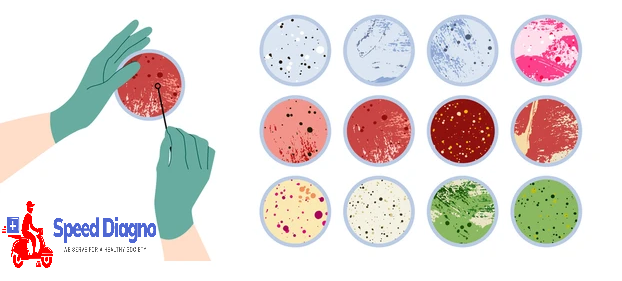- Home
-
Test Categories
- Diabetes
- Urinary
- Thyroid
- RTPCR
- Genetic
- Cancer
- Haematology
- Biochemistry
- Serology & Immunology
- Clinical Pathology
- Cytology
- Microbiology
- Endocrinology
- Histopathology
- MOLECULAR DIAGNOSTICS
- Pregnancy(Biochemistry)
- Liver
- Prostate
- Fertility
- Gastro
- Autoimmune Disorders
- Heart
- Kidney
- Vitamins
- Tuberculosis (TB)
- Anemia
- Fever
- Allergy
- Blood Tests Rare
- Profiles
- Packages
- About Us
- Why Choose Us
- Upload Prescription
- Corporate Wellness
- Contact Us

-
Overview
Culture and Sensitivity (C&S) is a diagnostic test used to detect the presence of pathogenic microorganisms (bacteria, fungi, etc.) in various body samples, such as blood, urine, sputum, wound, and other bodily fluids or tissues. The test involves culturing the sample in a lab to grow the microorganisms present, followed by sensitivity testing to determine which antibiotics or antifungal medications are most effective in treating the identified pathogens. This test is crucial for diagnosing infections, guiding appropriate antimicrobial therapy, and preventing the development of antibiotic resistance.
Patient Preparation for Culture and Sensitivity
Fasting Requirements:
- Fasting: Most C&S tests do not require fasting, but specific instructions may vary depending on the type of sample. For example, blood culture may be taken during fever spikes to enhance detection.
Other Preparations:
- Avoid Antibiotics: If possible, collect samples before starting any antibiotics to avoid false-negative results. Inform the healthcare provider about any current medications.
- Hygiene: Follow any specific instructions related to the sample type (e.g., clean the area before urine collection, or avoid mouthwash before a throat swab).
Sample Collection Process by Speediagno Phlebotomist or Technician:
Speediagno ensures a professional and sterile environment for sample collection, adhering to strict protocols to prevent contamination and ensure the accuracy of culture and sensitivity results.
Preparation for Sample Collection:
- Identify the Patient: The technician confirms the patient’s identity using at least two identifiers (e.g., name and date of birth).
- Consent and Explanation: The procedure is explained to the patient, including the importance of proper collection techniques to avoid contamination.
Sample Collection Process (Varies by Sample Type):
Blood Culture:
- Hand Hygiene and PPE: The technician wears gloves and other protective equipment to prevent contamination.
- Site Preparation: The skin is disinfected with antiseptic (e.g., chlorhexidine) before venipuncture.
- Collection: Blood is drawn using sterile equipment and placed into culture bottles designed for aerobic and anaerobic conditions.
Urine Culture:
- Midstream Clean-Catch: The patient cleans the genital area, starts urinating, pauses, and then collects midstream urine in a sterile container.
Sputum Culture:
- Early Morning Collection: The patient is instructed to cough deeply to produce sputum from the lungs into a sterile container.
Throat Swab Culture:
- Swabbing Technique: The technician uses a sterile swab to collect a sample from the back of the throat, avoiding contact with other areas.
Wound Culture:
- Wound Preparation: The area is cleaned, and a swab or tissue sample is taken from the infected site.
Post-Collection Care:
- Labeling and Transport: Each sample is labeled with the patient’s details and immediately transported to the lab under proper conditions to maintain sample integrity.
Safety and Hygiene Protocols:
- Proper Disposal: All used materials are disposed of in biohazard containers according to safety guidelines.
- Documentation: The collection process is documented accurately to ensure correct processing and traceability.
Laboratory Processing:
- Culture: Samples are cultured in media appropriate for the suspected pathogens (bacteria, fungi, etc.).
- Sensitivity Testing: Identified organisms undergo sensitivity testing against various antibiotics to determine the most effective treatment.
This comprehensive and meticulous approach ensures accurate identification of infections and effective treatment planning, contributing to improved patient outcomes.
All test groups and subgroup
-
CULTURE AND SENSITIVITY
-
Culture Method
-
Sample
-
Culture Method
-
Culture Report:
-
-
Antibiotic Sensitivity (Kirby - Bauer Disc Diffusion Method)(DEFAULT)
-
Amoxicillin(AMX)
-
Amikacin(AK)
-
Azithromycin(AZ)
-
Aztreonam(AT)
-
Amoxicillin clavulanate(AMC)
-
Cefixime(FIX)
-
Cefazolin(CFZ)
-
Ceftazidime(CAZ)
-
Cefuroxime(XM)
-
Cefdinir(CD)
-
Cefotaxime(CTX)
-
Cefotriaxone(CRO)
-
Chloramphenicol(C)
-
Ciprofloxacin(CL)
-
Ofloxacin(OF)
-
Cephalexin(CFM)
-
Gentamicin(GM)
-
Norfloxacin(NOR)
-
Nitrofurantoin(NL)
-
Nalidixic Acid(NA)
-
Penicillin(P)
-
Piperacillin(PL)
-
Tetracycline(TE)
-
CO-Trimoxazole(SXT)
-
Erythromycin(EM)
-
